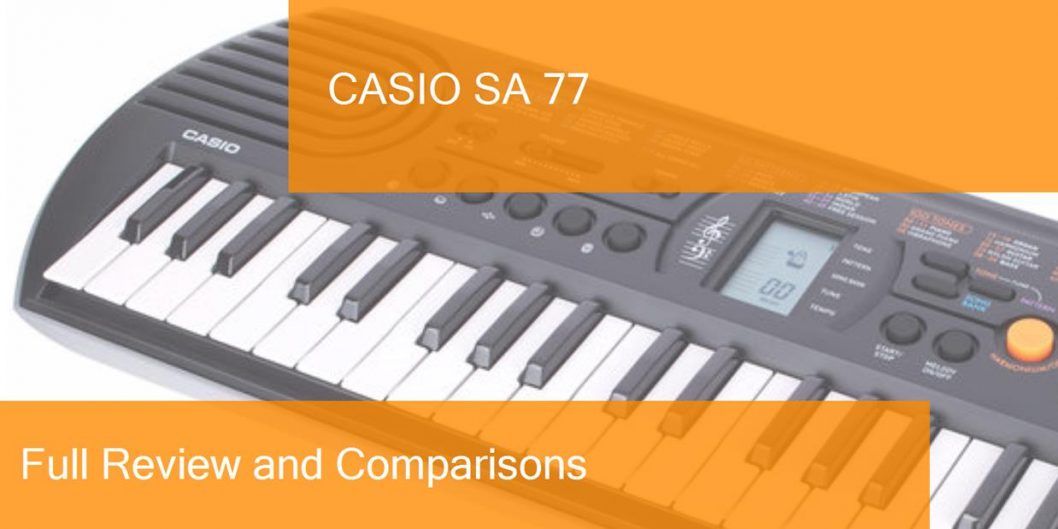
Casio Digital Piano SA 77 Review Complete. Good choice?
Casio being its full name and corporate name Casio Computer Co., Ltd. is an electronics manufacturer founded in 1946 and based in Tokyo, Japan. Casio has always had a catalog of miniature keyboards, which can serve as a gift for a child with a musical aptitude or for a person who has the desire to start learning to play the keyboard on a very limited budget, as their value is around 55 euros.
The Casio SA- 77 can be a fun keyboard that can be useful in certain cases and here we show you its main features:
- 44 mini keys without touch sensitivity
- 8 notes of polyphony (Number of notes that can be played at once. This includes accompaniments that also consume notes. So if you play over an accompaniment more notes will be accumulated)s
- 100 sounds (Different sounds of piano and other instruments)
- 50 styles (Accompanying styles that adapt to the chords we are playing. For example they will put a bass and a drum kit that will adapt and synchronize with the notes we are playing on the keyboard)
- 10 themes for practice
- 5 Drum-Pads to play rhythms (Accompanying rhythms that adapt to what you are playing. There are bossa nova rhythms, etc. Sometimes they are also known as accompaniment styles)
- LC display
- 2 speakers of 0.8W. This is a keyboard designed more like a toy
- Hull exit
- Its reduced weight of 1.4 kg makes it ideal in case you want to take it to teach ideas to other musicians without further pretensions
- Works with batteries or with the optional Casio AD-E95100 charger
I have selected this video that although the kid is very motivated with the keyboard serves to see it with optimism… the keyboard is what it is for the price it has but the video comes well to hear how it sounds:
Related post you can be interested in
- Ranking with the best digital pianos
- My selection of cheap musical keyboards.
- Basic concepts you need to know about digital pianos.
- The best resources to learn to play the piano by yourself.
- The best Casio Digital Pianos.
Now let’s compare the Casio SA 77 with its more common alternatives. Also at the end of the post you will find a section with the best shopping possibilities for this digital piano. But you can go directly to that part of the post by pressing the following button.
Casio SA 77 vs Casio SA 47
We will compare both models of miniature keyboards, the Casio SA 77 which, as already mentioned, has a value of €57/$54/£52 and the Casio SA 47 which has a value of €38/$44/£35. Let’s see if this difference is worth the features they offer:
- The Casio SA 77 gives us 44 mini keys, while the SA 47, 32 mini keys. Neither has touch sensitivity, which means that even if we play loudly or softly, we will always have the same intensity of sound.
- Both have 8 notes of polyphony, which means that a maximum of 8 notes can be played at the same time. Both have 100 different sounds, 50 styles/rhythms to accompany, and 10 themes to practice.
- Both keyboards have 5 Drum-pads to play rhythms or percussions.
- A notable difference is that the SA 77 has a 0.8W speaker output and the SA 47 has a 0.5W speaker output.
- On both keyboards the body is black.
We will put the characteristics of each of these pianos in 2 different columns to make it easier to see the differences:
|
Casio SA 77 |
Casio SA 47 |
|---|---|
|
|
And now a video of the Casio SA 47
If you want to know more about this model don’t miss our review of the Casio SA 46. (same model)
Casio SA 77 vs. Casio SA 76
Actually both Casios SA 77 and 76, are almost identical. The SA 77 has a value of €57/$54/£52, while the SA 76 has a value of €57/$54/£52, and has the very similar characteristics that you are sure to find below. One notable difference is that the base of the SA 77 is black like the rest of the body, and the Casio SA 76 is orange.
We will put the characteristics of each of these pianos in 2 different columns to make it easier to see the differences:
|
Casio SA 77 |
Casio SA 76 |
|---|---|
|
|
A video of the Casio SA 76:
If you want to know more about this model don’t miss our review of the Casio SA 76
Casio SA 77 vs. Casio SA 78
Actually both Casios SA 77 and 78, are almost identical. Both are worth 55 Euros, and have the very similar characteristics that you are sure to find below. One notable difference is that the base of the SA 77 is black like the rest of the body, and the Casio SA 78 is red.
We will put the characteristics of each of these pianos in 2 different columns to make it easier to see the differences:
|
Casio SA 77 |
Casio SA 78 |
|---|---|
|
|
A video showing the unboxing and mini review of the Casio SA 78:
If you want to know more about this model don’t miss our review of the Casio SA 78
Casio SA 77 vs. Casio MA 150
We will now make a comparison between the Casios SA 77 with a value of 55 euros and the MA 150 with a value of around 80 euros. We will check if the price difference is related to what their different features offer, and so we also make a jump from the so called SA series.
- The Casio SA 77 has 44 mini keys, while the Casio MA 150 has 49 mini keys. None of them offer sensitivity in the keys, which means that even if we play the strong or weak note it will always sound with the same intensity.
- Both have 8 notes of polyphony, which means that you can play a maximum of 8 notes at the same time.
- The SA 77 offers 100 different sounds with 50 styles/rhythms for accompaniment, the MA 150 offers 50 different sounds with 30 styles/rhythms for accompaniment.
- Both offer 5 Drum-pads for rhythms or percussion.
- The MA 150 has a metronome option for correct song timing, a function not found in the SA 77.
- Both have 0.8 W speakers.
- And as a main difference the MA 150 has a MIDI connection which serves to connect the keyboard to a music composition or production program and use it as a MIDI controller.
It is clear that the MA-150 has functions, not only as a keyboard but also thanks to its Metronome and MIDI connection, as a MIDI controller.
We will put the characteristics of each of these pianos in 2 different columns to make it easier to see the differences:
|
Casio SA 77 |
Casio MA 150 |
|---|---|
|
|
A video showing covers played with the Casio MA-150:
Where to buy Casio SA 77
Amazon
- Free Shipping and possibility of shipping in one day with Amazon Premium.
- Full Guarantee but they are no experts in music equipment.
- Sometimes better price.
- He’s got worse stock than Thomann.
Thomann
- Free Shipping.
- Full warranty. If you have any problems, they take care of everything.
- 100% reliable payment.
- Leader in trouble-free shipping.
- Usually Best price.
- Best Reputation: They are the leading online store in Europe and have the best catalogue and information.
Check below related models with similar price and features:
- Thomann DP 26
- Thomann SP 320
- Yamaha NP 32 Piaggero
- Korg Tiny Piano
- Startone MK 300
- Startone MK 200
- Yamaha PSR E463
- Yamaha PSR E363
- Startone MKR 61
- Roland GO KEYS
- Casio SA 46
- Casio SA 47
- Casio CTK 240
- Casio CT X700
- Yamaha EZ 220
- Yamaha PSR E263
- Yamaha PSR EW300
- Casio LK 280
- Casio SA 76
- Casio CTK 3500
- Casio LK 265
- Casio LK 136
- Casio CTK 1500
- Casio SA 77
- Yamaha Sonogenic SHS 500
- Casio SA 78
- Casio CTK 2500
- Yamaha YPT 260
- Roland GO PIANO
- Midiplus Stage 88


